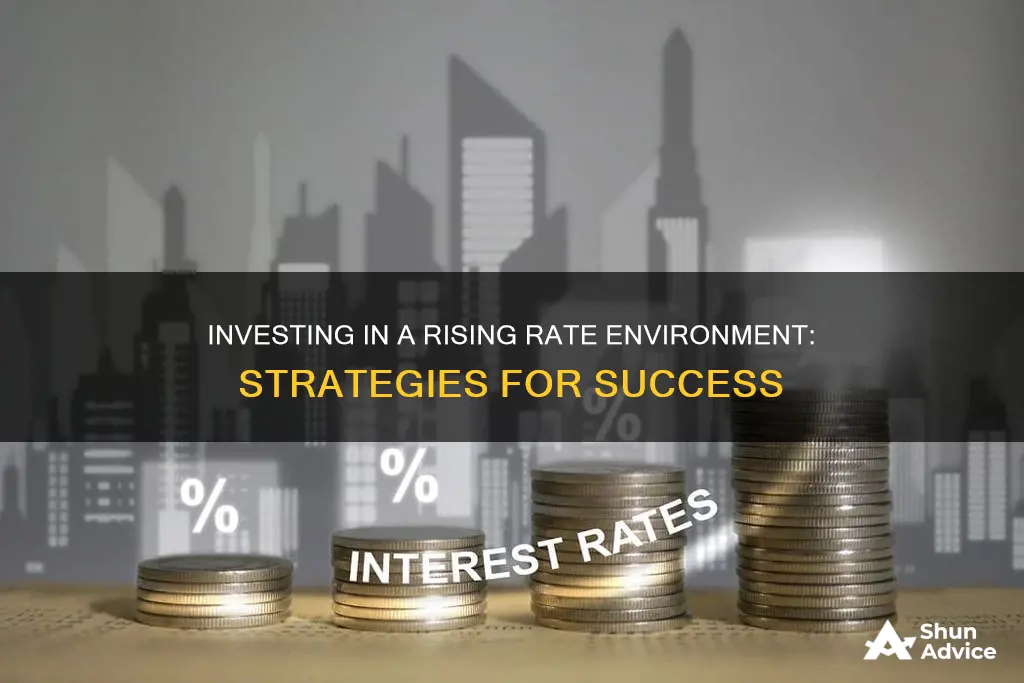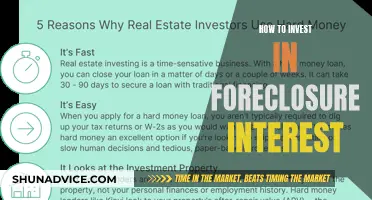
As interest rates rise, investors may be concerned about whether to buy an investment product now or wait. When choosing investments, the duration of the investment is just as important as yield. Investors should be cautious in this environment of rising rates, as they could get stuck owning a CD, bond or other investment that is no longer competitive if rates rise. It is important to have a clear understanding of your total monthly living expenses and keep enough liquidity to cover six to 18 months' expenses in your reserves.
| Characteristics | Values |
|---|---|
| Understanding monthly living expenses | Be certain to think holistically and include expenses such as insurance and taxes |
| Savings | Keep six to nine months' living expenses in liquid bank accounts |
| Investment duration | Short- and middle-term investments can help you avoid getting locked into any particular purchase for too long |
| Financial advisor | Update your savings and investment tactics with the guidance of a financial advisor |
What You'll Learn

Understand your monthly living expenses
It's important to understand your monthly living expenses before investing as interest rates rise. This includes expenses such as insurance and taxes. For those with a steady income, it is recommended to keep six to nine months' living expenses in liquid bank accounts. For those with multiple or fluctuating income sources, such as business owners, it is suggested to keep enough liquidity to cover 12 to 18 months' expenses in reserves. When there is a disruption in income, the higher the income level, the longer it will typically take to replace that income with another source.
Once you have a clear understanding of your monthly living expenses, you can update your savings and investment tactics with the guidance of a financial advisor. They can help you adjust your strategy to leverage the potential increasing interest rates. It is important to be cautious in this environment of rising rates, as you could get stuck owning an investment that is no longer competitive if rates rise.
One way to avoid getting locked into any particular purchase for too long is to purchase short- and middle-term investments. For example, rather than purchasing 3- or 4-year investments, you could purchase investments that mature after six, 12 or 18 months. This will give you the flexibility to evaluate the current interest rate environment as your investments mature.
As rates climb, you may be wondering whether you should buy an enticing investment product now or wait. It is important to seek the guidance of a financial advisor to help you make informed decisions that align with your financial goals and risk tolerance.
Interest Rates: Impacting Investment Patterns and Decisions
You may want to see also

Consult a financial advisor
When interest rates rise, it's important to consult a financial advisor to help you make the right investment decisions. They can guide you on how to update your savings and investment tactics to leverage the potential of increasing interest rates.
Before meeting with your advisor, it's a good idea to have a clear understanding of your total monthly living expenses, including insurances and taxes. This will help you determine how much you can afford to invest. For those with a steady income, it's generally recommended to keep six to nine months' living expenses in liquid bank accounts. However, for business owners or those with fluctuating income sources, it's suggested to keep enough liquidity to cover 12 to 18 months' expenses in reserves.
When choosing investments, the duration of the investment is just as important as the yield. You don't want to get stuck with a long-term investment that becomes uncompetitive if rates continue to rise. To avoid this, consider purchasing short- and middle-term investments that mature after six, 12, or 18 months. This will give you the flexibility to adjust your investment strategy as interest rates change.
Remember, it's crucial to seek professional advice when making investment decisions, especially in a rising interest rate environment. A financial advisor can provide personalised guidance based on your financial situation and goals.
Understanding Interest Expense: Carry Forward Rules for Investors
You may want to see also

Consider the duration of your investment
When interest rates are rising, it's important to consider the duration of your investment. This is just as important as yield, according to Terrell, a financial advisor. If you invest in a product with a long duration, you run the risk of interest rates rising further during the period of your investment, which could make your investment less competitive.
To avoid this, you could consider purchasing short- and middle-term investments, such as CDs (certificates of deposit) that mature after six, 12 or 18 months, rather than locking your money away for three or four years. This will allow you to benefit from rising interest rates sooner, and you can always reinvest your money at a higher rate once the initial investment matures.
It's also worth keeping in mind that, as rates climb, you might be tempted to buy an enticing investment product straight away. However, Terrell suggests that it's worth taking a step back to evaluate the current interest rate environment as your investments mature, so you don't get stuck with an uncompetitive product.
Before making any investment decisions, it's important to understand your total monthly living expenses and keep enough liquidity to cover these expenses for at least six months. For those with a steadier income, it's advised to keep six to nine months' living expenses in liquid bank accounts, while business owners or those with multiple income sources should keep enough liquidity to cover 12 to 18 months' expenses.
Investments: Compounding Interest Options for Your Money
You may want to see also

Be cautious of getting locked into a particular purchase
When interest rates rise, it's important to be cautious of getting locked into a particular purchase. You could get stuck owning a CD, bond or other investment that is no longer competitive if rates rise further. To avoid this, consider purchasing short- and middle-term investments that mature after six, 12 or 18 months, rather than locking yourself into a three- or four-year commitment.
It's also important to keep a clear understanding of your total monthly living expenses. This includes expenses such as insurance and taxes. For those with a steady income, it's advised to keep six to nine months' living expenses in liquid bank accounts. For those with multiple and fluctuating income sources, such as business owners, it's suggested to keep enough liquidity to cover 12 to 18 months' expenses in your reserves.
When interest rates rise, it's a good idea to consult a financial advisor to help you adjust your savings and investment tactics. They can help you leverage the potential of increasing interest rates and make sure you don't get locked into any particular purchase.
Remember, as rates climb, it's understandable to fret over whether to buy an investment product now or wait. However, by being cautious and seeking professional guidance, you can make informed decisions that align with your financial goals and risk tolerance.
Interest Rates: Impact on Savings and Investments
You may want to see also

Evaluate the current interest rate environment
Evaluating the current interest rate environment is crucial when considering how to invest as interest rates rise. It is important to understand how much in liquid funds you should keep at hand, and to update your savings and investment tactics with the guidance of your financial advisor. This will allow you to adjust your strategy to leverage the potential of increasing interest rates.
When choosing investments, the duration of the investment is just as important as the yield. You have to be cautious in an environment of rising rates, as you could get stuck with an investment that is no longer competitive if rates rise further. For example, purchasing short- and middle-term CDs and other investments can help you avoid getting locked into any particular purchase for too long. Rather than purchasing 3- or 4-year CDs, you could purchase CDs that mature after six, 12 or 18 months.
It is also important to have a clear understanding of your total monthly living expenses when evaluating the current interest rate environment. This includes expenses such as insurance and taxes. For those with a steady income, it is recommended to keep six to nine months' living expenses in liquid bank accounts. For those with multiple or fluctuating income sources, it is suggested to keep enough liquidity to cover 12 to 18 months' expenses in reserves.
By evaluating the current interest rate environment and considering the duration of investments, monthly expenses, and liquidity, you can make informed decisions about how to invest as interest rates rise.
Cash in Investment Portfolios: Gaining Interest?
You may want to see also
Frequently asked questions
First, identify how much in liquid funds you should keep at hand. Then, update your savings and investment tactics with the guidance of your financial advisor.
The duration of your investment is just as important as yield. You could get stuck owning a CD, bond or other investment that is no longer competitive if rates rise. Purchasing short- and middle-term CDs and other investments can help you avoid getting locked into any particular purchase for too long.
For those with a steady income, it is advised to keep six to nine months' living expenses in liquid bank accounts. For those with multiple and fluctuating income sources, keep enough liquidity to cover 12 to 18 months' expenses in your reserves.
As rates climb, it's understandable that you might be fretting over whether you should buy an investment product now or wait. You can come up for air and evaluate the current interest rate environment as your investments mature.
Be certain to think holistically and include expenses such as insurance and taxes.







